#marcianopolis
Explore tagged Tumblr posts
Text
Coin of the Day #242 (1/1/2025)
Happy 2025! Throwback to 225 here…


Roman Province - Moesia
AE25 - 8.97g
Severus Alexander 222-235 AD
Marcianopolis Mint
Obverse AYT K M AYP CEYH AΛEΞANΔPOC
Bust of Severus Alexander right, laureate, draped, cuirassed, from behind
Reverse YΠ TIB IOYΛ ΦHCTOY MAPKIANOΠOΛITΩN
Demeter standing front, holding corn ears and cornucopiae
RPC VI 1638
#coin of the day#roman empire#roman province#ancient rome#severus alexander#marcianopolis#moesia#roman coins#numismatics#coin#coins#ancient coins#demeter
2 notes
·
View notes
Text
Coin of the Day #41 (6/14/2023)
Happy Pride Elagabalus!
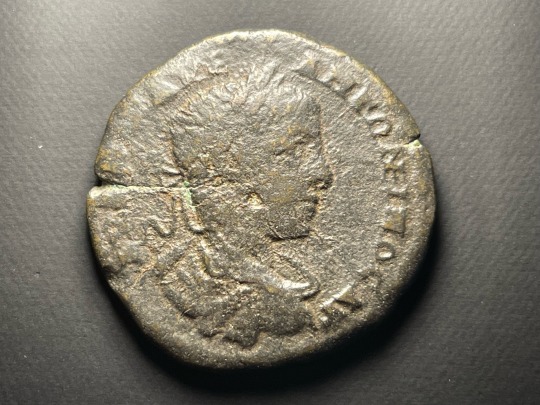

Roman Province - Moesia
AE25 - 6.72g
Elagabalus (+ Julius Antonius Seleucus) 218-222 AD
Marcianopolis Mint
Obverse ΑΥΤ Κ Μ ΑΥΡ ΑΝΤΩΝΕΙΝΟC ΑΥΓ
Bust of Elagabalus right, laureate, draped, cuirassed
Reverse ΥΠ ΙΟΥΛ ΑΝΤ CΕΛΕΥΚΟΥ ΜΑΡΚΙΑΝΟΠΟΛΙΤΩΝ
Nemesis standing left, holding scales and rod, wheel at feet
RPC VI 1484
happy pride to whatever the fuck elagabalus was doing
#coin of the day#roman empire#roman province#moesia#elagabalus#ancient rome#marcianopolis#roman coins#coin#coins#numismatics#pride month#ancient coins
20 notes
·
View notes
Text

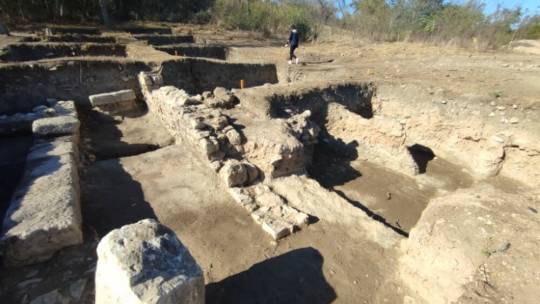
Archaeologists Discovered Roman Floor Mosaics in Bulgaria
Archaeologists discovered floor mosaics with early Christian designs and nearly 800 artifacts in the archaeological reserve of Marcianopolis in Devnya, in the northeastern part of Bulgaria.
The Roman town of Marcianopolis (present-day Devnya) in northeastern Bulgaria appears to have originated as a Thracian settlement. It was later inhabited by Hellenized settlers from Asia Minor and named Parthenopolis.

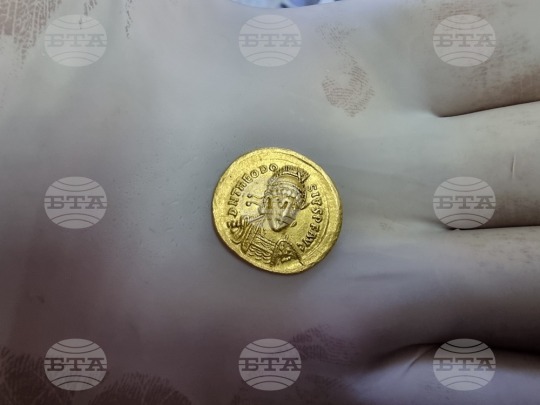
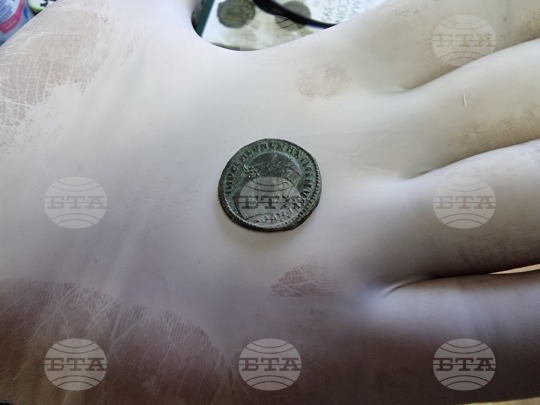
Roman Marcianopolis was established around 106 CE, following Trajan’s campaigns in Dacia to the north. The settlement was named after his sister, Ulpia Marciana. At the crossroads between Odessos (modern Varna), Durostorum, and Nicopolis ad Istrum, as well as the location of plentiful springs, Marcianopolis became a strategically important settlement.
Diocletian’s administrative reforms in the late third century CE divided Moesia Inferior into Moesia Secunda and Scythia Minor, with Marcianopolis serving as the former’s administrative capital. Marcianopolis experienced its most prosperous period during the middle of the fourth century CE. From 367 CE to 369 CE, the eastern emperor Valens used Marcianopolis as his winter quarters during campaigns against Visigoth incursions in the region. During this time, it served as the Eastern Empire’s temporary capital.

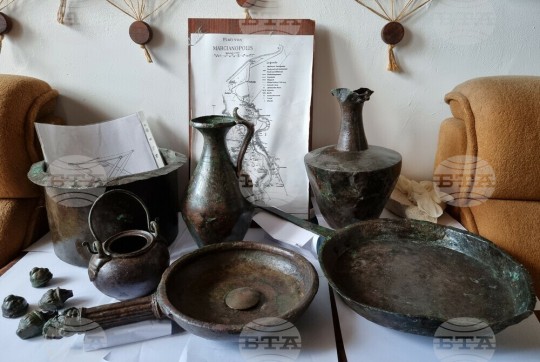

Floor mosaics with early Christian designs were found in the remains of a building. Archaeologists are not yet sure whether it was a public building or it belonged to a rich Roman citizen.
The tentative dating of the mosaics is in the first half of the 4th century AD.
The finds from the current archaeological season in Devnya contain another thousand bronze coins, several clay lamps and two clay vessels, which are awaiting scientific processing and restoration.
During the past archeological season, researchers restored bronze vessels discovered in the 1990s in a brick-walled tomb dating to the late 2nd – early 3rd century.
The vessels had a ritual use and were related to the personality of the person buried, Mosaic Museum director Ivan Sutev said in a statement to BTA.
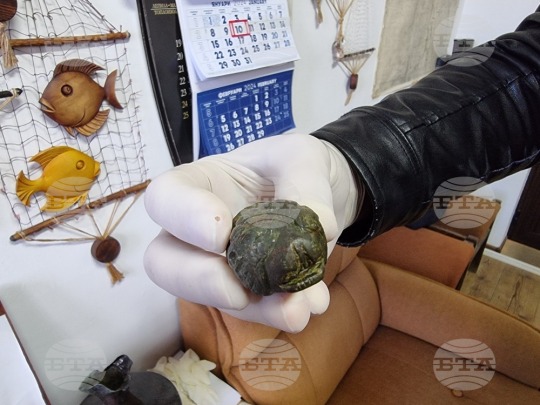

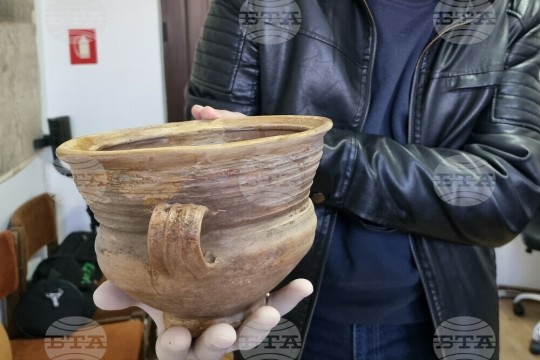

They are richly decorated and the workmanship is exquisite, he added. The find includes a vessel for pouring liquids as offering to a deity, and a wine jug with a trefoil mouth (oenochoe). A simple kitchen pan was also found along with these. All this leads archaeologists to suggest that a Roman citizen of Marcianopolis may have been laid to rest in the tomb, but that he may have had more specific functions: a soldier, a cook, or even a priest, Sutev said.
Pottery that was discovered in the basilica’s environs during excavations in 2023 has since been restored. Among these are a mortarium vessel for liquids and an exquisite crater-shaped pot for liquids. These were located in the structure with the mosaic floors. Coins from the time of Emperor Theodosius II were also found scattered on the floor.
In 447, Attila’s Huns captured and destroyed Marcionopolis after conquering the entire Balkan Peninsula but failing to capture Constantinople. That is determined by 20 gold coins scattered on the floor of the building being studied. On one side of the coins is an image of Theodosius II, while on the other is the patron goddess of Constantinople. Among the coins discovered during the Marcianopolis excavations were those from the city’s founding in the second century. The latter are dated to the sixth century, around the time of Emperor Justinian.
By Oguz Buyukyildirim.
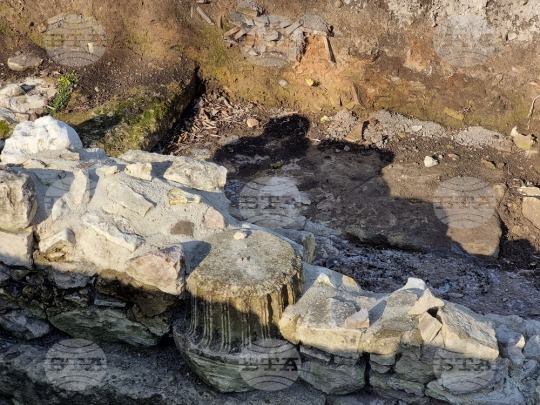
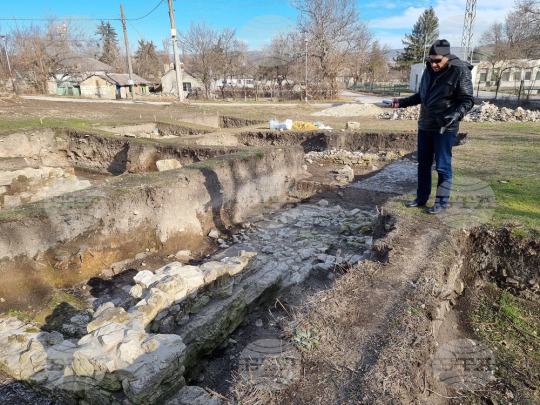
#Archaeologists Discovered Roman Floor Mosaics in Bulgaria#The Roman town of Marcianopolis#gold#gold coins#roman gold coins#ancient artifacts#archeology#archeolgst#history#history news#ancient history#ancient culture#ancient civilizations#roman history#roman empire#roman art#Emperor Theodosius II
44 notes
·
View notes
Text
SAINTS&READING: SUNDAY, SEPTEMBER 29, 2024
september 16_september 29
St. SEBASTIANA, DISCIPLE OF St. PAUL THE APOSTLE, MARTYRED AT HERACLEA (86).

The Holy Martyr Sebastiana was a follower of the holy Apostle Paul. During a persecution against Christians under the emperor Dometian (81-96), she was on trial as a Christian before the governor named Georgios in the city of Marcianopolis in the Mizea region.
Saint Sebastiana firmly confessed her faith in Christ, and for this she was subjected to cruel tortures. At first they beat her, and then they threw her into a red-hot oven, from which she emerged unharmed. They sent the saint to the city of Heraklea, where sentence was pronounced on her a second time.
The governor, named Pompian, gave orders to tie the saint to a tree and lacerate her body with roof tiles. The martyr remained unbroken in her faith. Then the governor gave her to be eaten by wild beasts. The Lord also preserved the holy martyr, and the beasts refused to touch her. Then, by order of the governor, Saint Sebastiana was beheaded. Her body, thrown into the sea, was taken by angels to the island of Rhodes (in Thrace, in the Sea of Marmara).
Source: Orthodox Church in America_OCA
TRANSLATION OF THE RELICS OF ST ALEXI OF MOSCOW (2001).

...not seeking mine own profit but the profit of many, that they may be saved (I Cor. 10:33)
These words were spoken at the funeral of Archpriest Alexey Mechev who, in the years proceeding his death in 1923, was popularly esteemed among Moscow' s outstanding pastors. He was a rare example of a married priest endowed with clairvoyance, a gift which enabled him to heal countless battered souls, in the tradition of the great Optina elders whose spiritual offspring he was. And like St. John of Kronstadt, another of his mentors, this skilled physician operated in the midst of a great metropolis with all the complexities that this brings to life.
Although no formal biography exists, memoirs left by his spiritual children reveal a wealth of pastoral experience and counsel that can be effectively applied even now to souls oppressed by the multiple distractions and demands of today's world.
Fr. Alexey was born in 1860, the son of a choir director in the service of the great Metropolitan Philaret of Moscow (+1867). The family lived in modest circumstances. "I never had a room of my own," Fr. Alexey recalled. "All my life I've lived with people around!" Judging from the only extant letter to his wife Anna, he was happily married; they had several children before her tragically premature death. None of the children appear to have remained close to their father with the exception of a son Sergius who succeeded Fr. Alexey as priest at St. Nicholas' church on Maroseyka street, before joining the ranks of Russia's New Martyrs in 1941.
Fr. Alexey's success did not blossom overnight. Describing the early years of his pastorate he said:
"For eight years I served the Liturgy daily in an empty church. One archpriest said to me: 'No matter when I pass by your church, the bells are always ringing. Once I went in--nobody. Nothing will come of it. You're ringing in vain." But Fr. Alexey steadfastly continued serving--and the people began to come, many people. He would tell this story when asked how to establish a parish. The answer was always the same: "Pray."
"In his domestic life," writes one of his spiritual children, "Batiushka was extremely simple and humble. In his study, in his little room, there were piles of books--some lying open, letters, lots of prosphora on the table, a folded epitrachelion lying together with a cross and Gospel, and little icons. The general chaos indicated that Batiushka was always busy, that he never had spare time, that there was always waiting for him--at home, on the street, in church--some great task calling for his love and self-sacrifice."
"Live for others, and you yourself will be saved." This was Fr. Alexey's motto. "To be with people," he would say, "to live their life, rejoice in their joys, sorrow over their misfortunes ... herein lies the meaning and way of life for a Christian, and especially for a pastor."
Fr. Alexey's own life was consumed in the service of others, The same spiritual son writes: "Outside his apartment the line of laboring and heavy-laden stood from early morning. And Batiushka managed to have a talk with each of them, to caress, to console ..." "Never, it seems," recalls another, "was he ever alone. He was always with people, and in sight of people; it was as though the walls of his room were glass -everything was visible ... He told me two or three times toward the end that he'd like to be off by himself, that people were getting the best of him. But that was just two or three times--no more. “Let' s all go to a monastery!” he'd say half in jest. 'You, me--all of us together!'"
Many people, particularly intellectuals, had difficulty understanding and accepting Fr. Alexey's approach because, quite simply, they didn't understand the essence of Christianity. This is well illustrated by the case of Vladimir S.:
Knowledge puffeth up, but charity edifieth
"I became acquainted with Batiushka soon after the February Revolution of 1917. I remember that when I first went to the church on Maroseyka, there was a lot there that bothered me. It was, in fact, a real conflict between the mind and the heart, between adherence to the law on the one hand, and a profound love--covering and fulfilling the law--on the other hand ... I was bothered because my love for God was weak, because I saw religion simply as a path towards satisfying a thirsty and curious intellect. I liked the strict, well-ordered and harmonious system of dogmas, I delighted in the beauty and universal conformity of the ecclesiastical rites. I believed in God, I was devoted to the Church, but I had little love for the Lord. And this cold, rational attitude towards religion subsequently ruined me, and even led me to leave Batiushka ...
"When I came to Maroseyka ... I saw the following: a priest of small stature, with a lined face and tangled beard, was serving together with an old deacon. The priest wore a faded, violet kamilavka; he served somehow hurriedly and, it seemed, carelessly: he was forever coming out of the altar to give confession at the cliros; sometimes he talked or searched for someone with his eyes; he himself carried out and distributed the prosphora.
"All this--and especially the confession during Liturgy--had an irritating effect on me. And the fact that a woman read the Epistle, and that there were too many communicants, and the uncalled-for Blessing of the Water [after Liturgy] ... None of this agreed with my conviction that conformity in church rites was absolutely essential. /.../
"[But gradually] I became involuntarily attached to Maroseyka; I became accustomed to the church services, and their deviations from the Typicon no longer bothered me. On the contrary, nowhere could I pray so fervently as at Maroseyka. Here one sensed that the walls were permeated by prayer, one sensed a contagious prayerful atmosphere which one didn't find in other churches. Some people, whether by tradition or out of desire to hear a deacon and choir, go to wealthy and renowned churches; here people came for one reason alone--to pray ...
"It happened that one would come to Father Alexey with some complex dogmatic problem. He would say with a smile: 'Why are you asking me; I'm an ignoramus' ... 'You're forever wanting to live through your mind; you should try to live as I do--through the heart.' This 'life through the heart' explained many of the deviations in church service which Batiushka permitted. When reason said that it was necessary to observe the prescriptions of the Typicon--not to confess during Liturgy, not to take out prosphora after the Cherubic Hymn, not to communicate late-comers at the north door after Liturgy, etc., etc.--Batiushka's heart, burning and overflowing with love, caused him to disregard reason.
'How can I possibly refuse someone confession,' he would say. 'Perhaps this confession is the person's last hope, perhaps by turning him away I may cause the ruin of his soul. Christ didn't refuse anyone. He said to everyone: "Come unto Me ..." You say, What about the law? But where there is no love, the law does not work unto salvation; true love, however, is the fulfillment of the law (Rom. 13:8-10).'"
Vladimir's comments may leave the impression that Fr. Alexey didn't particularly care or wasn't well-versed in the Church service rules. This isn't true:
"A first-rate expert on the Typicon and the services, he noticed everything, saw everything, all the mistakes and omissions in the service, especially with those young people with whom he served in his latter years (and he loved serving with them). But he left the impression that he saw nothing, noticed nothing. After some time had passed, at a convenient and appropriate moment, he'd bring up the matter and correct it. The more glaring errors--or the ones which had some bearing on the service--he'd correct himself in a manner so discreet that it passed unnoticed by the server who had erred, much less by the congregation: he himself would start to sing in the proper manner, or would do something that someone else was supposed to have done. This is a very rare quality among the clergy."
Fr. Alexey often said that "each person has his own particular path to salvation. One mustn't set a common path for everyone; one mustn't try to workout a formula for salvation which would apply to all people. People are born with different natures, different abilities, intellects and constitutions--so, too, they each go towards Christ at their own pace, each on his own path. Because of this, Christianity considers equally soul-saving the chaste monastic life and marital life, the priesthood and laity, the rank of soldier and the rank of judge--as long as Christ dwells in the heart ... And the task of an elder or a spiritual father is to uncover a person's calling and to point out to him the path which he should take towards the Lord."
With his gift of clairvoyance, Fr. Alexey had no need to speak to his "patients" in order to diagnose their maladies. And his "treatments" showed this masterful physician to be a man "not of words, but of spirit, of power:"
"It seemed that Batiushka didn't really say much; from his face alone, his smile, his eyes, there streamed such gentleness, such understanding, that this in itself comforted and encouraged a person without any words ... He actually, as he himself put it, 'unloaded' people's sins; he transformed people from despairing, oppressed pessimists into Christians constantly rejoicing in the Lord. One had only to glance at his commemoration book, checkered with hundreds of names of both living and dead, a book he always had with him, and one understood the words which he spoke, pointing to his heart: 'I carry you all here.’”
The scope of Fr. Alexey’s pastoral influence may be judged by the tens of thousands who gathered for his funeral. The liturgy was served by Bishop Theodore Pozdeyev (later, archbishop and New Martyr), attended by 80 clergymen--hierarchs, priests and deacons. The imprisoned Patriarch Tikhon, freed for a few hours, met the cortege at the St. Lazarus cemetery, where he served a lity for the deceased. Altogether, it was a fitting tribute to this remarkable pastor who had been, for so many, a stepping-stone to God.
(Quotations translated from Otets Aleksei Mechev; YMCA Press, Paris, 1970)
Source:


Galatians 2:16-20
16 knowing that a man is not justified by the works of the law but by faith in Jesus Christ, even we have believed in Christ Jesus, that we might be justified by faith in Christ and not by the works of the law; for by the works of the law no flesh shall be justified. 17 But if, while we seek to be justified by Christ, we ourselves also are found sinners, is Christ therefore a minister of sin? Certainly not! 18 For if I build again those things which I destroyed, I make myself a transgressor. 19 For I through the law died to the law that I might live to God. 20 I have been crucified with Christ; it is no longer I who live, but Christ lives in me; and the life which I now live in the flesh I live by faith in the Son of God, who loved me and gave Himself for me.
Mark 8:34-9:1
34 When He had called the people to Himself, with His disciples also, He said to them, "Whoever desires to come after Me, let him deny himself, and take up his cross, and follow Me. 35 For whoever desires to save his life will lose it, but whoever loses his life for My sake and the gospel's will save it. 36 For what will it profit a man if he gains the whole world, and loses his own soul? 37 Or what will a man give in exchange for his soul? 38 For whoever is ashamed of Me and My words in this adulterous and sinful generation, of him the Son of Man also will be ashamed when He comes in the glory of His Father with the holy angels.
1 And He said to them, "Assuredly, I say to you that there are some standing here who will not taste death till they see the kingdom of God present with power."
#orthodoxy#orthodoxchristianity#easternorthodoxchurch#originofchristianity#holyscriptures#gospel#bible#spirituality#wisdom#faith#martyrs#jesusuchrist
2 notes
·
View notes
Text
The Holy Martyr Theodotus suffered with Saints Maximus and Asklepiodote, at the beginning of the fourth century under the emperor Maximian Galerius (AD 305-311). Eminent citizens of the city of Marcianopolis (in modern Bulgaria), Maximus, and Asklepiodote led a devout Christian life. By their example they brought many to faith in Christ and to holy Baptism.
During the persecution, Tiris, the governor of Thrace, went around the city subject to him and persecuted those believing in Christ. He summoned Maximus and Asklepiodote before him and demanded they abandon the Christian Faith. When the martyrs refused, he ordered that they be beaten.
Then a certain pious man named Theodotus, began to reproach the governor for his inhumanity and cruelty. They seized him also, and hanging him on a tree, they tortured him with iron hooks. After this, they threw the three martyrs into prison. Tiris traveled for two weeks more and took the holy martyrs along with him.
In the city of Adrianopolis, he put them to still greater tortures, commanding that their bodies be scorched with white-hot plates. In the midst of their suffering they heard a Voice from Heaven encouraging them to persevere. After several days of torture they threw the martyrs to be eaten by wild beasts in the circus, but instead the she-bear released upon Saints Maximus and Theodotus began to cuddle up to them.Saint Asklepiodote was tied to a bull, but she seemed to be rooted to the spot, and did not budge.
Tiris resumed the journey and stopped in the village of Saltis before reaching the city of Philippopolis. Again he urged the martyrs to renounce Christ. When they refused, he ordered them to be beheaded on this day in AD 310.
Almighty God, who gave to your servants Theodotus, Maximus, and Asklepiodote boldness to confess the Name of our Savior Jesus Christ before the rulers of this world, and courage to die for this faith: Grant that we may always be ready to give a reason for the hope that is in us, and to suffer gladly for the sake of our Lord Jesus Christ; who lives and reigns with you and the Holy Spirit, one God, forever and ever.
Amen.

3 notes
·
View notes
Link
An artefact made of terracotta has been discovered at the Dzhanavara site in the Bulgarian Black Sea city of Varna, a news conference at the Regional Archaeological Museum was told on February 12.
The find, made during excavations of an early Christian monastery, is part of a mask or bust and most likely portrays an emperor’s face. It is estimated to date back to the sixth century.
The museum’s Vassil Tenekedzhiev said that the fragment had been identified, after consultations with other archaeologists, as a one of a kind.
Continue reading
#classics#tagamemnon#tagitus#history#ancient history#terracotta#emperor#archaeology#archaeologists#varna#bulgaria#regional archaeological museum#Vassil Tenekedzhiev#Marcianopolis#roman city#late antique#early Byzantine monastery#early Christian monastery#sixth century#excavations#archaeological excavations
5 notes
·
View notes
Photo

Nicopolis ad Istrum and Marcianopolis
The Latin language infiltrated much more easily than elsewhere. This was mainly due to the presence of the army, which required a common language for communication. In the civilian settlements lived Roman citizens who had acquired these privileges by birth as Italians or by army service. They were the vehicles of the dominant language and culture in this province. The official Roman cults underlay the religious life in this area. In the 2nd century people from other parts of the Empire, primarily from the Hellenic East, came here, with the army or as civilians. Their presence however was not so conspicuous as in the cities in the interior.
Nicopolis ad Istrum and Marcianopolis, although to the north of the Haemus Mountain, initially belonged to the province of Thrace, and after 193 to Lower Moesia. Here the influence of the Greek language and culture was stronger. The government was on the model of the Greek poleis in the Eastern Mediterranean. The construction of the squares and their architectural decoration gives out the hand of the Eastern master. This influence is also evident in the cities south of the Balkan Range.
Mediterranean Dacia
The urbanization in Thrace was at a higher level compared to Moesia. What is more, with the exception of the ancient Greek poleis on the western Black Sea coast, until the reign of Trajan there were no urban centers in Moesia. In Thrace, Philippopolis was undoubtedly the most magnificent, large and beautiful city. Although during the first three centuries it was not a provincial center, it remained the most famous in these lands. Later it was chosen to be capital of the province of Thrace with the homonymous diocese of Thrace. Serdica became the chief city of Mediterranean Dacia, and Marcianopolis – capital of Second Moesia.
In Thrace the Hellenic influence persisted. The Greek language was spoken and written mainly in the cities, while in the villages Thracian dialects were used tour packages balkan. In the sphere of culture, art and religion, the local tradition was intertwined with influences from the neighboring Greek lands. In many aspects of life is evident a mixture of these two cultures and beliefs, the so- called syncretism.
The population was ethnically variegated. Three main groups were predominant. The Greeks were dominant in the seaside settlements, but they gradually penetrated into the interior. With the urbanization of Thrace and Moesia, many immigrants came from the Hellenic poleis in the eastern Mediterranean world (Nicomedia, Ephes, Smirna, etc.). Quite a few Syrians, Egyptians and Judeans also settled here. In the two provinces many Roman citizens lived too.
These were mostly veteran soldiers who received plots of land. They had adequate organizational and administrative experience, acquired during their long service. In the villages such men usually became mayors, and were often in the city government. The Thracian element, so strong in the rural areas, gradually penetrated in the cities. Wealthy local elite emerged, who occupied public and sacral posts. Men from different parts of the Empire served here (in the legions and their auxiliary units). In the 4th century, however, ethnic changes set in. Along the lower Danube and in the interior, federate tribes (allies) mostly of Gothic origin were settled. Gradually the so-called barbarian elements penetrated into Moesia and Thrace, in the military and civil life.
Even though not as imposing in appearance as the cities in Italy, North Africa and Asia Minor, the explored Roman period cities in Bulgaria exhibit a high urban development in comparison to other marginal or bordering provinces of the Empire.
2 notes
·
View notes
Photo

Nicopolis ad Istrum and Marcianopolis
The Latin language infiltrated much more easily than elsewhere. This was mainly due to the presence of the army, which required a common language for communication. In the civilian settlements lived Roman citizens who had acquired these privileges by birth as Italians or by army service. They were the vehicles of the dominant language and culture in this province. The official Roman cults underlay the religious life in this area. In the 2nd century people from other parts of the Empire, primarily from the Hellenic East, came here, with the army or as civilians. Their presence however was not so conspicuous as in the cities in the interior.
Nicopolis ad Istrum and Marcianopolis, although to the north of the Haemus Mountain, initially belonged to the province of Thrace, and after 193 to Lower Moesia. Here the influence of the Greek language and culture was stronger. The government was on the model of the Greek poleis in the Eastern Mediterranean. The construction of the squares and their architectural decoration gives out the hand of the Eastern master. This influence is also evident in the cities south of the Balkan Range.
Mediterranean Dacia
The urbanization in Thrace was at a higher level compared to Moesia. What is more, with the exception of the ancient Greek poleis on the western Black Sea coast, until the reign of Trajan there were no urban centers in Moesia. In Thrace, Philippopolis was undoubtedly the most magnificent, large and beautiful city. Although during the first three centuries it was not a provincial center, it remained the most famous in these lands. Later it was chosen to be capital of the province of Thrace with the homonymous diocese of Thrace. Serdica became the chief city of Mediterranean Dacia, and Marcianopolis – capital of Second Moesia.
In Thrace the Hellenic influence persisted. The Greek language was spoken and written mainly in the cities, while in the villages Thracian dialects were used tour packages balkan. In the sphere of culture, art and religion, the local tradition was intertwined with influences from the neighboring Greek lands. In many aspects of life is evident a mixture of these two cultures and beliefs, the so- called syncretism.
The population was ethnically variegated. Three main groups were predominant. The Greeks were dominant in the seaside settlements, but they gradually penetrated into the interior. With the urbanization of Thrace and Moesia, many immigrants came from the Hellenic poleis in the eastern Mediterranean world (Nicomedia, Ephes, Smirna, etc.). Quite a few Syrians, Egyptians and Judeans also settled here. In the two provinces many Roman citizens lived too.
These were mostly veteran soldiers who received plots of land. They had adequate organizational and administrative experience, acquired during their long service. In the villages such men usually became mayors, and were often in the city government. The Thracian element, so strong in the rural areas, gradually penetrated in the cities. Wealthy local elite emerged, who occupied public and sacral posts. Men from different parts of the Empire served here (in the legions and their auxiliary units). In the 4th century, however, ethnic changes set in. Along the lower Danube and in the interior, federate tribes (allies) mostly of Gothic origin were settled. Gradually the so-called barbarian elements penetrated into Moesia and Thrace, in the military and civil life.
Even though not as imposing in appearance as the cities in Italy, North Africa and Asia Minor, the explored Roman period cities in Bulgaria exhibit a high urban development in comparison to other marginal or bordering provinces of the Empire.
2 notes
·
View notes
Photo

Nicopolis ad Istrum and Marcianopolis
The Latin language infiltrated much more easily than elsewhere. This was mainly due to the presence of the army, which required a common language for communication. In the civilian settlements lived Roman citizens who had acquired these privileges by birth as Italians or by army service. They were the vehicles of the dominant language and culture in this province. The official Roman cults underlay the religious life in this area. In the 2nd century people from other parts of the Empire, primarily from the Hellenic East, came here, with the army or as civilians. Their presence however was not so conspicuous as in the cities in the interior.
Nicopolis ad Istrum and Marcianopolis, although to the north of the Haemus Mountain, initially belonged to the province of Thrace, and after 193 to Lower Moesia. Here the influence of the Greek language and culture was stronger. The government was on the model of the Greek poleis in the Eastern Mediterranean. The construction of the squares and their architectural decoration gives out the hand of the Eastern master. This influence is also evident in the cities south of the Balkan Range.
Mediterranean Dacia
The urbanization in Thrace was at a higher level compared to Moesia. What is more, with the exception of the ancient Greek poleis on the western Black Sea coast, until the reign of Trajan there were no urban centers in Moesia. In Thrace, Philippopolis was undoubtedly the most magnificent, large and beautiful city. Although during the first three centuries it was not a provincial center, it remained the most famous in these lands. Later it was chosen to be capital of the province of Thrace with the homonymous diocese of Thrace. Serdica became the chief city of Mediterranean Dacia, and Marcianopolis – capital of Second Moesia.
In Thrace the Hellenic influence persisted. The Greek language was spoken and written mainly in the cities, while in the villages Thracian dialects were used tour packages balkan. In the sphere of culture, art and religion, the local tradition was intertwined with influences from the neighboring Greek lands. In many aspects of life is evident a mixture of these two cultures and beliefs, the so- called syncretism.
The population was ethnically variegated. Three main groups were predominant. The Greeks were dominant in the seaside settlements, but they gradually penetrated into the interior. With the urbanization of Thrace and Moesia, many immigrants came from the Hellenic poleis in the eastern Mediterranean world (Nicomedia, Ephes, Smirna, etc.). Quite a few Syrians, Egyptians and Judeans also settled here. In the two provinces many Roman citizens lived too.
These were mostly veteran soldiers who received plots of land. They had adequate organizational and administrative experience, acquired during their long service. In the villages such men usually became mayors, and were often in the city government. The Thracian element, so strong in the rural areas, gradually penetrated in the cities. Wealthy local elite emerged, who occupied public and sacral posts. Men from different parts of the Empire served here (in the legions and their auxiliary units). In the 4th century, however, ethnic changes set in. Along the lower Danube and in the interior, federate tribes (allies) mostly of Gothic origin were settled. Gradually the so-called barbarian elements penetrated into Moesia and Thrace, in the military and civil life.
Even though not as imposing in appearance as the cities in Italy, North Africa and Asia Minor, the explored Roman period cities in Bulgaria exhibit a high urban development in comparison to other marginal or bordering provinces of the Empire.
1 note
·
View note
Photo

Nicopolis ad Istrum and Marcianopolis
The Latin language infiltrated much more easily than elsewhere. This was mainly due to the presence of the army, which required a common language for communication. In the civilian settlements lived Roman citizens who had acquired these privileges by birth as Italians or by army service. They were the vehicles of the dominant language and culture in this province. The official Roman cults underlay the religious life in this area. In the 2nd century people from other parts of the Empire, primarily from the Hellenic East, came here, with the army or as civilians. Their presence however was not so conspicuous as in the cities in the interior.
Nicopolis ad Istrum and Marcianopolis, although to the north of the Haemus Mountain, initially belonged to the province of Thrace, and after 193 to Lower Moesia. Here the influence of the Greek language and culture was stronger. The government was on the model of the Greek poleis in the Eastern Mediterranean. The construction of the squares and their architectural decoration gives out the hand of the Eastern master. This influence is also evident in the cities south of the Balkan Range.
Mediterranean Dacia
The urbanization in Thrace was at a higher level compared to Moesia. What is more, with the exception of the ancient Greek poleis on the western Black Sea coast, until the reign of Trajan there were no urban centers in Moesia. In Thrace, Philippopolis was undoubtedly the most magnificent, large and beautiful city. Although during the first three centuries it was not a provincial center, it remained the most famous in these lands. Later it was chosen to be capital of the province of Thrace with the homonymous diocese of Thrace. Serdica became the chief city of Mediterranean Dacia, and Marcianopolis – capital of Second Moesia.
In Thrace the Hellenic influence persisted. The Greek language was spoken and written mainly in the cities, while in the villages Thracian dialects were used tour packages balkan. In the sphere of culture, art and religion, the local tradition was intertwined with influences from the neighboring Greek lands. In many aspects of life is evident a mixture of these two cultures and beliefs, the so- called syncretism.
The population was ethnically variegated. Three main groups were predominant. The Greeks were dominant in the seaside settlements, but they gradually penetrated into the interior. With the urbanization of Thrace and Moesia, many immigrants came from the Hellenic poleis in the eastern Mediterranean world (Nicomedia, Ephes, Smirna, etc.). Quite a few Syrians, Egyptians and Judeans also settled here. In the two provinces many Roman citizens lived too.
These were mostly veteran soldiers who received plots of land. They had adequate organizational and administrative experience, acquired during their long service. In the villages such men usually became mayors, and were often in the city government. The Thracian element, so strong in the rural areas, gradually penetrated in the cities. Wealthy local elite emerged, who occupied public and sacral posts. Men from different parts of the Empire served here (in the legions and their auxiliary units). In the 4th century, however, ethnic changes set in. Along the lower Danube and in the interior, federate tribes (allies) mostly of Gothic origin were settled. Gradually the so-called barbarian elements penetrated into Moesia and Thrace, in the military and civil life.
Even though not as imposing in appearance as the cities in Italy, North Africa and Asia Minor, the explored Roman period cities in Bulgaria exhibit a high urban development in comparison to other marginal or bordering provinces of the Empire.
1 note
·
View note
Photo

Nicopolis ad Istrum and Marcianopolis
The Latin language infiltrated much more easily than elsewhere. This was mainly due to the presence of the army, which required a common language for communication. In the civilian settlements lived Roman citizens who had acquired these privileges by birth as Italians or by army service. They were the vehicles of the dominant language and culture in this province. The official Roman cults underlay the religious life in this area. In the 2nd century people from other parts of the Empire, primarily from the Hellenic East, came here, with the army or as civilians. Their presence however was not so conspicuous as in the cities in the interior.
Nicopolis ad Istrum and Marcianopolis, although to the north of the Haemus Mountain, initially belonged to the province of Thrace, and after 193 to Lower Moesia. Here the influence of the Greek language and culture was stronger. The government was on the model of the Greek poleis in the Eastern Mediterranean. The construction of the squares and their architectural decoration gives out the hand of the Eastern master. This influence is also evident in the cities south of the Balkan Range.
Mediterranean Dacia
The urbanization in Thrace was at a higher level compared to Moesia. What is more, with the exception of the ancient Greek poleis on the western Black Sea coast, until the reign of Trajan there were no urban centers in Moesia. In Thrace, Philippopolis was undoubtedly the most magnificent, large and beautiful city. Although during the first three centuries it was not a provincial center, it remained the most famous in these lands. Later it was chosen to be capital of the province of Thrace with the homonymous diocese of Thrace. Serdica became the chief city of Mediterranean Dacia, and Marcianopolis – capital of Second Moesia.
In Thrace the Hellenic influence persisted. The Greek language was spoken and written mainly in the cities, while in the villages Thracian dialects were used tour packages balkan. In the sphere of culture, art and religion, the local tradition was intertwined with influences from the neighboring Greek lands. In many aspects of life is evident a mixture of these two cultures and beliefs, the so- called syncretism.
The population was ethnically variegated. Three main groups were predominant. The Greeks were dominant in the seaside settlements, but they gradually penetrated into the interior. With the urbanization of Thrace and Moesia, many immigrants came from the Hellenic poleis in the eastern Mediterranean world (Nicomedia, Ephes, Smirna, etc.). Quite a few Syrians, Egyptians and Judeans also settled here. In the two provinces many Roman citizens lived too.
These were mostly veteran soldiers who received plots of land. They had adequate organizational and administrative experience, acquired during their long service. In the villages such men usually became mayors, and were often in the city government. The Thracian element, so strong in the rural areas, gradually penetrated in the cities. Wealthy local elite emerged, who occupied public and sacral posts. Men from different parts of the Empire served here (in the legions and their auxiliary units). In the 4th century, however, ethnic changes set in. Along the lower Danube and in the interior, federate tribes (allies) mostly of Gothic origin were settled. Gradually the so-called barbarian elements penetrated into Moesia and Thrace, in the military and civil life.
Even though not as imposing in appearance as the cities in Italy, North Africa and Asia Minor, the explored Roman period cities in Bulgaria exhibit a high urban development in comparison to other marginal or bordering provinces of the Empire.
0 notes
Text
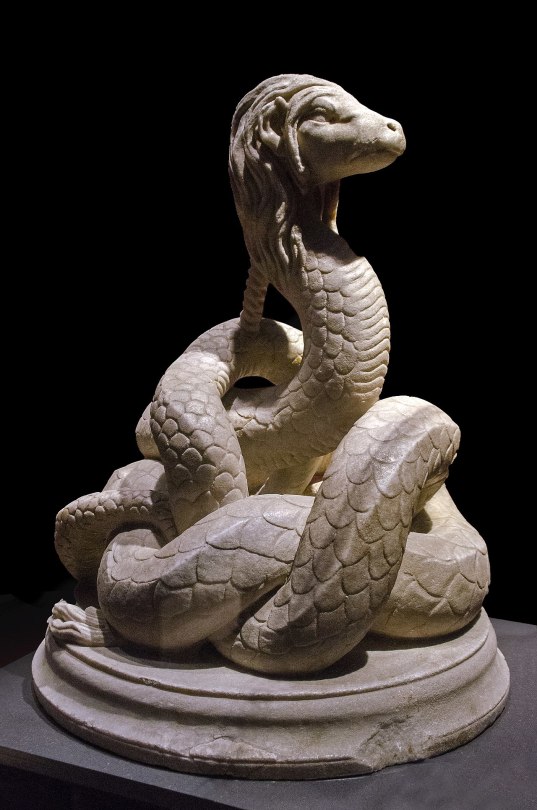
The Glykon Snake
The Glykon was an ancient snake god which had an influential cult within the Roman Empire in the 2nd century.
It was created by the prophet Alexander of Abonoteichos, who claimed it was a new incarnation of Asclepius.
Glykon was a snake with the features of a man on his face, including long, blond hair.
It seems that the snake was actually a puppet which appeared in the temple.
Much like earlier Macedonian snake centered cults, the focus of the worship at the temple was on fertility.
By 160, the worship of Glykon had spread beyond the Aegean and even the Emperor Marcus Aurelius sought prophesies from Alexander and his snake god.
Glykon worship was found throughout the vast area between the Danube and Euphrates.
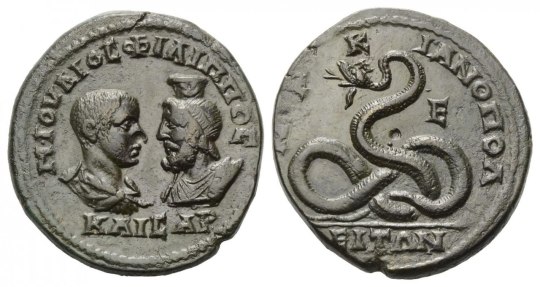
Pentassarion issued under Roman emperor Philip II. in Marcianopolis.
Beginning late in the reign of Antoninus Pius and continuing into the 3rd century, official Roman coins were struck in honor of Glykon, attesting his popularity.
The cult continued for at least a hundred years after Alexander's death.

A marble statue of Glykon was found during an excavation under the former Pallas railway station in Constanța, Romania.
Currently, the statue is displayed at the Constanța History and Archaeology Museum.
#scultpure#art#history#dark academia#aesthetic#roman empire#ancient history#mythology#snake god#glykon snake#glykon#glycon#asclepius#museum#ancient#archeology#marcus aurelius#Alexander of Abonoteichos#constanța#romania#ancient culture#i saw it at the museum yesterday :)#light academia
91 notes
·
View notes
Photo

MOESIA INFERIOR, Marcianopolis. Gordian III. AD 238-244. Æ Tetrassarion (26mm, 8.81 g, 7h). Tullius Menophilus, legatus consularis. Struck AD 239-240. Laureate, draped, and cuirassed bust right / Castor standing left, holding scepter and horse by bridle behind. H&J, Marcianopolis 6.36.24.1; Varbanov 1919. Near VF, green surfaces, some roughness. Rare.
0 notes
Photo

Today we also celebrate the Holy Martyr Sebastiana of Heraclea. Saint Sebastiana was a follower of the holy Apostle Paul. During a persecution against Christians under the emperor Dometian (81-96), she was on trial as a Christian before the governor named Georgios in the city of Marcianopolis in the Mizea region. Saint Sebastiana firmly confessed her faith in Christ, and for this she was subjected to cruel tortures. At first they beat her, and then they threw her into a red-hot oven, from which she emerged unharmed. They sent the saint to the city of Heraklea, where sentence was pronounced on her a second time. The governor, named Pompian, gave orders to tie the saint to a tree and lacerate her body with roof-tiles. The martyr remained unbroken in her faith. Then the governor gave her to be eaten by wild beasts. There too, the Lord preserved the holy martyr, and the beasts refused to touch her. Then, by order of the governor, Saint Sebastiana was beheaded. Her body, thrown into the sea, was taken by angels to the island of Rhodes (in Thrace, in the Sea of Marmara). May she intercede for us always + Source: https://www.oca.org/saints/lives/2006/09/16/102628-saint-sebastiana-the-martyr-disciple-of-saint-paul-the-apostle-a (at Bitola) https://www.instagram.com/p/CkGXV2kD1vN/?igshid=NGJjMDIxMWI=
1 note
·
View note
Text
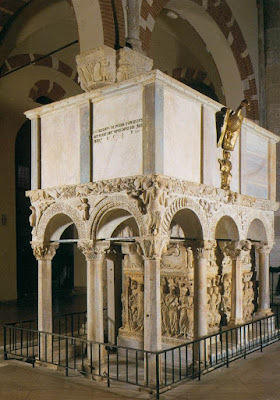
Milano - Sant’Ambrogio - Sarcofago di Stilicone - IV sec.
Milano è al centro della storia dal tardo impero romano all’Alto Medioevo. Di seguito la cronologia dei fatti.
44 a. C. Assassinio di Giulio Cesare. Il Senato di Mediolanum dedica una statua a Bruto, già governatore della Cisalpina. Ottaviano Augusto imperatore
42 a. C. Romanizzazione della Cisalpina
9 Varo sconfitto a Teutoburgo dal barbaro romanizzato Arminio
14 Tiberio succede ad Augusto
37 Caligola
41 Claudio
54 Nerone
68 Fine della dinastia Giulio-Claudia. L'anno dei quattro imperatori: Galba, Ottone, Vitellio, Vespasiano
70 Inizio della costruzione dell'Anfiteatro Flavio
79 Tito. Eruzione di Pompei e conquista di Gerusalemme
81 Domiziano
96 Fine della dinastia Flavia, Nerva
98 Traiano
117 Adriano
138 Antonino Pio
161 Marco Aurelio. Peste Antonina
180 Commodo
193 Fine della dinastia Antonina. Pertinace, Didio Giuliano, Settimio Severo
212 Caracalla. Estensione della cittadinanza romana
217 Macrino
218 Eliogabalo
222 Alessandro Severo
235 Massimino il Trace
238 Gordiano, Gordiano II e Gordiano III
244 Filippo l’Arabo
249 Decio
251 Treboniano Gallo
253 Valeriano
260 Gallieno
268 Claudio II
270 Aureliano sconfigge i Barbari a Milano. Mura Aureliane a Roma
275 Tacito
276 Floriano, Aurelio Probo
282 Caro
284 Diocleziano e la tetrarchia con Galerio in Oriente e Massimiano / Costanzo Cloro in Occidente
288 Massimiano trasferisce la capitale d’Occidente a Milano che vive una crescita urbanistica e monumentale (anfiteatro, circo, terme erculee, …)
305 Abdicazione di Diocleziano e Massimiano. Galerio e Costanzo augusti
306 Costantino, figlio di Costanzo, e Massenzio, figlio di Massimiano, imperatori
307 Costantino sposa Fausta, figlia di Massimiano
312 Costantino sconfigge Massenzio a Ponte Milvio e diventa augusto d’Occidente
313 Licinio, augusto d’Oriente, sposa a Milano Costanza, sorella di Costantino. Editto di Milano
330 Costantinopoli capitale
324 Costantino sconfigge ad Adrianopoli Licinio
325 Il Concilio di Nicea vieta l’Arianesimo
337 Morte di Costantino. Costanzo II
355 Il Concilio di Milano condanna il paganesimo
361 Giuliano l'Apostata
364 Valentiniano
374 Ambrogio vescovo di Milano
375 Graziano
378 Sconfitta ad Adrianopoli dell’imperatore d’Oriente Valente.
379 Teodosio, chiamato in Oriente, per difendersi dai Goti, ne diventa imperatore. Graziano e Ambrogio, in Occidente, contrastano le eresie. Fondazione della Basilica Martyrum (poi Sant’Ambrogio)
382 Fondazione di San Nazaro e San Simpliciano
383 Valentiniano II
386 La madre di Valentiniano II, Giustina, si scontra con Ambrogio perché intende offrire la Basilica Portiana, oggi San Vittore al Corpo, agli ariani.
387 Conversione di Sant’Agostino
388 Teodosio imperatore, di fatto, anche d’Occidente per avere aiutato Valentiniano II contro Massimo, augusto della Gallia
394 Teodosio sconfigge gli usurpatori d’Occidente ed è ringraziato da Ambrogio
395 Muore a Milano Teodosio che affida al generale Stilicone i figli Onorio, imperatore d’Occidente, e Arcadio, imperatore d’Oriente
397 Muore Ambrogio
402 I Visigoti si avvicinano a Milano che cessa di essere capitale a vantaggio prima di Ravenna e poi di Roma dove Stilicone sposta Onorio e la sorella Galla Placidia, sposata con suo figlio
408 Stilicone, nonostante abbia fermato i Barbari, viene fatto decapitare da Onorio
410 Il re dei Goti e generale romano Alarico saccheggia Roma
425 Morte di Onorio. Valentiniano III, figlio di Galla Placidia sua tutrice, imperatore con il supporto di Ezio
436 Morte di Sant’Agostino ad Ippona durante l’assedio dei Visigoti
445 Attilla sconfigge a Marcianopoli Teodosio II imperatore d’Oriente
452 Papa Leone ferma Attila fuori Roma
453 Valentiniano III fa uccidere Ezio
476 Odoacre depone Romolo Augustolo
493 Teodorico, inviato dall’Imperatore d’Oriente Anastasio, sconfigge Odoacre
494 Dottrina di Papa Gelasio contro Anastasio
525 Morte di Severino Boezio a Pavia per via dei sospetti di tradimento nutriti da Teodorico
526 Morte di Teodorico. Gli succede il nipote Atalarico
527 Giustiniano imperatore d’Oriente. Sua moglie è Teodora
529 Benedetto da Norcia fonda il proprio ordine monastico a Montecassino come superamento dell’ascetismo orientale. Nello stesso anno, Giustiniano chiude l’Accademia neo-platonica di Atene.
531 Codice di Giustiniano
539 Distruzione di Milano da parte dei Goti. Nonostante la ricostruzione (es. San Giovanni in Conca, la debolezza della città la espone alla futura resa ai Longobardi)
540 Fine della guerra greco-gotica. Belisario conquista Ravenna
547 Sacco di Roma
554 Prammatica Sanzione: Giustiniano stabilisce il proprio potere in Italia
565 Muoiono Giustiniano e Belisario
584 Autari re dei Longobardi
590 La moglie Teodolinda risposa Agilulfo e sposta la capitale a Milano. Gregorio Magno papa
1 note
·
View note
Photo

Claudius Ptolemaeus from Alexandria in Egypt
The geographer Claudius Ptolemaeus from Alexandria in Egypt mentions Nicopolis on the river Nestum among the inland cities of the Thracian province. Across the fertile valley passed the important road from Philippopolis to the Aegean Sea. The area enclosed by the city walls was 12 hectares, and its shape was polygonal. Initially the settlement did not have a stonewall as it was situated in an interior land, unlike the right bank of the Danube, where the hazard of barbarian invasions was very high. The city was fortified as late as the
second half of the 4th century AD. From the wholly investigated southern wall are visible protruding towers and the gate. Inside, sectors of a large house with a colonnaded courtyard are uncovered. Off the southern wall a bathing structure catered for the needs of part of the citizens. It was built in the first quarter of the 4th century, but in 376-378 the Goths set it on fire. Later it was reconstructed but in the late 6th century the Avars and Slavs destroyed it. The building was totally ruined a little later by an earthquake.
Everyday life
Traces of a Thracian necropolis from the 1 st millennium BC have been found in the vicini-ty. The name of the tribe is still unknown.
When Nicopolis was founded, the population was of local Thracian or Greek origin. This is indicated by the numerous votive monuments to the Thracian Horseman, Zeus, Artemis, Hermes, Pluto. Greatly revered was also the local river god Nestos, who irrigated the valley and gave fertility. Treasures of coins from Histria, Latae, and particularly from the nearby island of Thasos, found in the area, speak of the connections of this region with other parts of the world. For a short period Nicopolis ad Nestum minted its own coins, from the reign of Commodus (180-192) to Caracalla (211-217).
In the 3rd-4th century a stonecutting workshop functioned in Nicopolis. It met the demands of the city and the surrounding set-tlements. Bases, columns, partition slabs, Dorian, Ionian and Roman-Corinthian capitals were produced. The local stonecutting school imitated the fashionable architectural details and types. Metallurgy and metal-working were also developed at a local level.
The citizens of Nicopolis enjoyed a precarious freedom during the Gothic wars of 376-378 and later, many of the besieged cities welcomed the invaders istanbul tourism conference. In many cases, when the barbarians came in, the administrative-tax burden was alleviated and sometimes even their attitude was better than the governors’. In other cases it was not so, if great resistance had been put up.
Historian Eunapius describes an instructive incident with the citizens of Nicopolis. They sneered at the other Thracians who expected help from the Emperor, which did not come. On the other hand, they cowardly awaited the enemy, uncertain about their fate. The citizens of Nicopolis however slighted those who were not able to defend themselves and precariously enjoyed their freedom.
The late antique author Socrates, who lived in the 5th century, mentions there was a bish-op in the city. Several early Christian basilicas have been found in the environs.
After a long interruption, human life continued here with a small settlement in the Bulgarian Middle Ages, between 10th-14th centuries.
Conclusion
The 14 Roman cities presented in this book sprang up near older Thracian settlements. The gifts of nature were used to the maximum – the cities were situated in plains, near a mountain, by pure drinking and mineral water springs, or on the bank of a large river (Marcianopolis, Serdica, Diocletianopolis, Pautalia, Philippopolis). The climate in the cities in Thrace was mild and agreeable, providing conditions for better living. In the Danube region the picture was a bit different. Here the winters were colder, with icy and searching winds, the springs and autumns were misty.
Ulpia Oescus, Novae and Durostorum were built on the right bank of the lower Danube. This was one of the most neuralgic zones at the Roman border (limes). Legions were stationed in all three of them. They had to repulse the barbarian attacks from the north. With the transfer of 5th Macedonian Legion, Oescus became a large city with the rank of a colony — the highest degree of provincial government. Later Novae and Durostorum became municipia. The administrative system was on the Italic model. The influence of Rome and the Italic cities, although on a smaller provincial scale, is also felt in the architecture. Thus, in Ulpia Oescus we have the typical elongated forum with temples, a basilica and a city hall (probably in the western part of the forum).
0 notes